This project looks at the significant fires that have occurred in Stockton High Street, which is an important part of our community.
Historically the area to be considered reflects two eras of development in the High street area. These are:
The earlier development of the high street when many roads led of the lower part of the High Street down towards the river Tees. Here there was not only residential accommodation in narrow streets but also small and medium sized warehouses and businesses plying their trade.
The modern development of the High Street with modern buildings almost segregating the High Street from the river. Given the decline of river traffic in thus more modern era the need for warehouses in this area along the Riverside declined and so did the number of dwellings. However this also saw a significant development of buildings in the high street.
The research covers period from early 19th Century to the present early 21st Century. The research aims to reflect the following:
The need for a Fire Service in Stockton-on Tees.
The organizational change of the Fire Service prior to 1947 and after 1947.
The significant fires that have occurred in and around the High Street area.
The changing roles of the fire service in Stockton-on-Tees
Stockton Fire Brigade
The first reference to a fire service in Stockton was made in 1871 when a committee was formed to look at the setting up of a fire Brigade
“At a quarterly meeting of the Town Council of the Borough of Stockton held at the Town Hall within the said Borough on the 9th day of November 1871…it was ordered that a Committee be appointed to consider the question of providing a proper Fire Brigade for the town and that such Committee consist of the following: - The Mayor (George Lockwood), Aldermen Jackson, Knowles, Wren, Laing; Councilors Byers, Wilson, Cadle and Richardson”. - Council Minutes, 1871. Heritage Stockton.
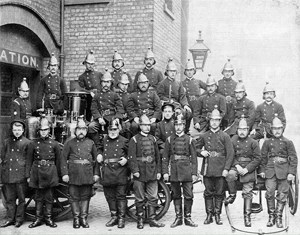
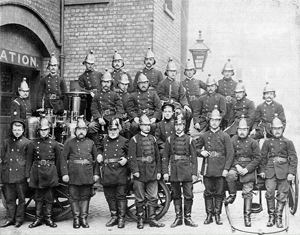
The first illustration of the Fire Service was in 1903 when the Fire Station was located in West Row. Note the number of firemen for this area and the heavy uniform and helmets used in these times. Image courtesy of Picture Stockton Archives.
The Fire Station was located on West Row - the road that joins Dovecot Street to Ramsgate. It offered good access to the High Street, men and equipment could get to the scene of fires quickly.
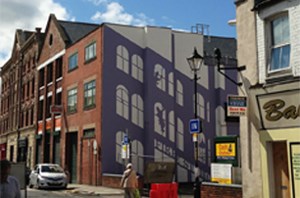
This area is referred to in the Northern Echo by reporter Chris Webber, July 11th 2013.
‘A mural is being constructed in West Row car park on the back of the newly restored West Row Arts building, behind the High Street. Titled A Century of Change it will be painted at the former site of what was Stockton Fire Station between 1883 and 1965. It has been specially designed by Stockton-based artist Zak Newton and is made up of three elements.
The first element is the painted representation of the shadow of what was previously there based on photographic records and depicts the old West Row facade and tower of the fire station.
The second element of the work is the fireplace, once the heart of every home. It is installed at first-floor level and is a fabricated reconstruction of a form typical of the early 20th Century’ s neo-Georgian style.
The third element occupies the west-facing gable end. It comprises three mirrored panels and three painted panels replicating the warehouse architecture of the area’ .
West Row fire station was in existence from 1883 to 1965, a total of eighty-two years on this site. However there is contradictory evidence that it closed in 1947 submitted by author Ron Henderson ‘County Durham & Darlington Fire & Rescue Service' Pub Tempus 1988; ‘The opening of the new fire station at Norton saw the closure of Stockton’s old fire station in West Row in 1948'.
Fires on the High Street
As can be seen from the analysis below it would be beyond the scope of this research to record all fires that have occurred in Stockton Town Centre, which includes the High Street. This is over a ten-year period. Table Total Incidents Stockton Town Centre Ward 1st April 2006 to 31st March 2016.
Incident Type |
Number |
% |
Primary Fires |
268 |
6.6 |
Secondary Fires |
1570 |
38.4 |
Special Services |
461 |
11.3 |
False Alarm Good Intents |
957 |
23.4 |
Malicious False Alarms |
87 |
2.1 |
False Alarms Apparatus |
746 |
18.2 |
Total |
4089 |
100 |
False alarms of the most prevalent type of incident followed by secondary fires. Information above supplied by Cleveland Fire Service May 2016.
Major fires that have occurred prior in this period
Tees Pottery: The first recorded fire was in 1832 and was recorded in the Newcastle Chronicle 15th December 1832. There was a small fire in the Tees Pottery, which was probably located in Pottery Street, Thornaby on Tees.
What is also evident is that the fire station in Stockton did not just service the needs of properties in Stockton High Street. A report in the Leeds Times dated 27th February 1841 records a large fire at Wynyard Hall outside of Stockton. It states that ‘An express was then despatched to Stockton for fire engines, which arrived, and began to play on flames about one o’clock on Saturday morning.... During the space of two hours the engines continued to play without intermission upon the advancing flames, but without effect. The fire had got to strong a hold, and, first to one room and to another, it appeared to be above all human control. Strenuous efforts were made to extinguish the flames, often at the risk of life and limb, but all without avail. The loss is supposed to be at least £300,000.’
Significant Fires in and around the High Street, Stockton-on-Tees
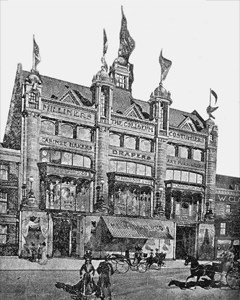
Robinsons Coliseum: In 1899 Robinson Coliseum a local department store caught fire. 'Just after midnight on the morning of Sunday 17 December 1899, Inspector McDonald and Sergeant Thompson of the Stockton Police were on duty on the High Street. As they passed the Parish Church they noticed sparks coming from the top of Robinson’s Coliseum as if a chimney was on fire. As they gazed upwards the officers were alarmed to see a sheet of flame shoot from the roof of the building'.
You probably recognise this store as Debenhams, which is at the north end of the High Street today on the same site. Not all the major fires were confined to the High Street. A number occurred within the confines of the Town Centre near to the High Street and were dealt with by the brigade at West Row or the new fire station based in Norton.
Image Source: Taken from Heavisides Almanack c1909, Picture Stockton Archives
The Old Picture House: The Old Picture House was located Dovecot Street. It burned down in 1932 and was rebuilt in 1964.
Tower Warehouse: A large turntable ladder was used as a water tower at Towers Warehouse, Stockton-on-Tees on 1st December 1951. Firemen were able to gain entry onto the second floor by means of a wheeled escape.
Mellanby’s Warehouse: The warehouse was gutted by a fire in 1954.
Woodworkers Shop: This fire occurred in the 1960’s in the south end of Stockton High Street opposite the Town Hall. It did significant damage to the building.
Queens Hotel: The Queens Hotel was a grand building situated in Bishopton Road West. This was near to Stockton Railway Station. The hotel caught fire on 30th January 1981.
Holy Trinity Church Stockton: One of the most recent and greatest losses to the people of Stockton was the fire that destroyed Holy Trinity Church just off Yarm Road Stockton. The Church was destroyed by fire in 1991. The cause of the fire was never established.
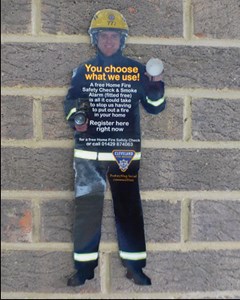
Fire Education Developments
From the period after the 2nd World War it has become evident in this research that the Fire Service as we know it has taken on additional roles which are in addition to fighting fires. This is in the role of Fire Prevention. This is where the general public are advised on managing items in the household to prevent fires. Here is an example of early material that was used in this process.
Reference: Cleveland Fire Brigade.
This briefly illustrates the history of the Fire Service and Fires based in and around Stockton High Street. Each incident will develop its own ‘Story From the High Street’.
Stories from the High Street participant: Gareth Rees.
The ‘Stories…’ project is part of the Council’s wider “Grants for Heritage Buildings’ programme, funded by the Heritage Lottery Fund and the Council, to help promote awareness and understanding of the town’s heritage.
Visit www.stockton.gov.uk/grantsforheritagebuildings for further information on the project.
